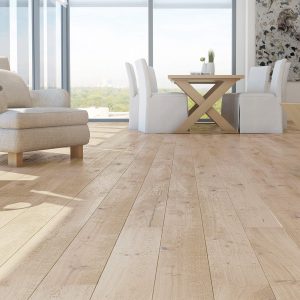Natural white oak floor offers a timeless appeal that works across modern, rustic, and transitional interiors. Its organic grain patterns, light neutral tones, and excellent durability make it a favored choice for both residential and commercial spaces. Whether installed in a high-traffic living room or a minimalist office, it adds warmth and structure while allowing design flexibility.

Material Characteristics and Composition
Species and Grain Pattern
White oak is a native North American hardwood known for its straight, tight grain and uniform texture. Compared to red oak, white oak has a smoother grain with fewer swirls and more linear figures, which creates a cleaner and more elegant surface. It is naturally less porous, making it more resistant to moisture and decay.
Color and Tone Variation
Natural white oak flooring is prized for its light beige to pale brown hues, which can have subtle golden or gray undertones depending on lighting and finish. Unlike stained floors, natural white oak maintains its authentic tone over time, aging gradually into a richer but still neutral patina.
Performance and Durability
Hardness and Longevity
With a Janka hardness rating of approximately 1360, white oak is among the more resilient domestic woods. This makes it suitable for busy households, pet traffic, and public interiors. It resists dents and scratches better than softer woods, and its closed-grain structure helps repel moisture absorption.
Surface Finishing Options
Natural white oak is versatile when it comes to finishing. It can be left raw for a Nordic look, or sealed with matte polyurethane for enhanced wear protection. Oil-based finishes deepen the grain and color, while water-based finishes preserve its pale tones. UV-cured hardwax oils are increasingly popular for their eco-friendliness and repairability.
Design Compatibility
Interior Styles and Aesthetic Harmony
Natural white oak floors are exceptionally adaptable. In Scandinavian interiors, they match white walls and simple furniture. In rustic settings, they complement darker beams and stone textures. In contemporary homes, they support open, bright spaces with clean lines. Their neutral palette allows homeowners to change decor over time without clashing with the floor.
Plank Sizes and Layout Patterns
Available in standard planks, wide widths, and even parquet designs like herringbone or chevron, white oak accommodates a variety of visual preferences. Wide planks enhance the grain and add a modern feel, while traditional strip flooring maintains a classic appearance. Custom layouts can add personality without sacrificing sophistication.
Installation and Maintenance
Site-Finished vs. Prefinished
Site-finished white oak offers seamless edges and customized stains, but requires longer installation time. Prefinished flooring comes with factory-applied finishes, offering quicker turnaround and better finish consistency. Both types provide strong protection when installed properly over a moisture-controlled subfloor.
Cleaning and Upkeep
Natural white oak flooring requires minimal daily maintenance. Sweeping or vacuuming with a hardwood-friendly tool removes debris. Damp mopping with a neutral pH cleaner helps preserve the finish. Avoiding excess moisture and using protective pads on furniture extends the floor’s life and appearance.
Sustainability and Sourcing
Environmental Impact
White oak harvested in North America typically comes from responsibly managed forests, especially when certified by organizations like FSC or PEFC. Its long life span and repairable nature also reduce the need for frequent replacement, lowering its environmental footprint compared to short-lifespan flooring products.
Reclaimed and Engineered Options
Reclaimed white oak offers historic character and reduces the demand for virgin timber. Engineered white oak provides structural stability and uses less solid wood, making it ideal for installations over concrete or radiant heat systems. Both options support eco-conscious design goals without sacrificing performance or aesthetics.




